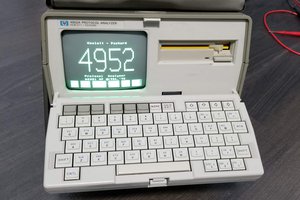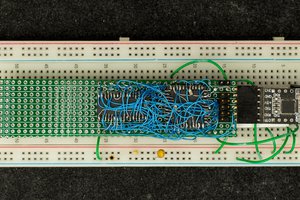ZZ80MB, a Z280-based SBC
Z80-compatible CP/M-ready SBC that can program itself
Z80-compatible CP/M-ready SBC that can program itself
To make the experience fit your profile, pick a username and tell us what interests you.
We found and based on your interests.
ZZ80MB_rev2_BOM.pdfBuild of Materials for ZZ80MB, rev 2Adobe Portable Document Format - 41.66 kB - 10/23/2020 at 12:02 |
|
|
ZZ80MB_Rev2.zipGerber photoplots of ZZ80MB, rev2x-zip-compressed - 29.00 kB - 10/23/2020 at 12:01 |
|
|
ZZ80MB_r2_scm.pdfSchematic of ZZ80MB, rev2Adobe Portable Document Format - 39.08 kB - 10/23/2020 at 12:00 |
|
|
This is a series of photographs showing how to assemble ZZ80MB.
Start off with bare pc board, component side & solder side.
I like to assemble a board with the lowest components first. This way, I can insert the component, flip it over, and use the weight of the board to keep the components flat against the pc board. So first group of components are through-hole 1/8W resistors.
Next is capacitors and a diode.
IC sockets, SIP resistor, and serial port header.
Two RC2014 expansion connectors are next
Last are PLCC socket, reset button, voltage regulator, 10uF tantalum cap, and power plug
CF adapter is quite tall, so it is assembled last. Here is ZZ80MB all assembled and populated.
I will cover programming and testing of ZZ80MB in next blog
Z280 has two modes of operations. In its native mode, it operates with 16-bit data bus and 24-bit of address. Z280 can also operate in Z80-compatible mode where it has a 8-bit data bus with 24-bit address, but only 64K of memory is accessible at any given time. In ZZ80MB Z280 is operating in Z80-compatible mode.
While Z280 was not a commercial success (too slow, too late), it contains many modern CPU features such as MMU, DMA, cache, and on-chip peripherals. One unusual feature of Z280 is its "serial bootstrap" function where it can be configured to boot without ROM through its serial port. With serial bootstrap, it receives 256 bytes of serial data and save them to memory location 0x0 to 0xFF. When the 256th byte has been received, it starts program execution from location 0x0. ZZ80MB utilizes the serial bootstrap function to load an EPROM programmer that can write the subsequent software into on-board EPROM.
Features of ZZ80MB are:
Create an account to leave a comment. Already have an account? Log In.
@Plasmode this is an interesting project and may be perfect for my own interests in building a tool chain from the "ground up" the hard way... boot loader, monitor, permeative assembler, editor, compiler, etc. I am thinking about crafting a stand-alone "virtual paper tape reader and punch" that could serial connect to perhaps this and also the 1802-based "membership card". Are you on the RC2014 list? Would you be interested in assistance in this project? And, what are your thoughts on a terminal for your board? Will it have two UARTs, one for the serial port of bootstrapping and another for say the VT-132 VT-100 emulator RC2014 expansion board?
Hi Todd,
I'm Bill Shen on Google Group RC2014-Z80. I'm also active on Google Group retro-comp which is closely related to RC2014, but with more advanced topics. In fact, I have started a discussion topic on ZZ80MB. https://groups.google.com/g/retro-comp/c/5sJDPVfEZgI
Z280 has only one UART although there are RC2014 expansion slots to add more serial ports. While the Z280 serial port is used for serial bootstrap, once the on-board EPROM is programmed and running, the serial port is available as the CP/M terminal, so it can certainly drive VT132.
I have discovered a bug on current version of ZZ80MB, revised pc board is being fabricated at JLCPCB. I should have it back next week. If you are in USA, I can send you a complimentary PC board and a Z280 and hopefully you have parts to fill in the rest.
Back in the early 1990's, I spent many wonderful evenings designing and building a Z280 demo board: http://www.bdug.org.au/project/computing/Z280 I wonder how small it could now be made using SMD components?
Z280 is only available in 68 PLCC, so that limits how small the board can be. I have a relatively small Z280 SBC operating in its native 16-bit mode and with 2 meg of DRAM, CF disk in 75mm X 100mm 2-layer pc board. https://www.retrobrewcomputers.org/doku.php?id=builderpages:plasmo:z280rc
BTW, thank you for your Z280 manual. That's the one I used, the 2 missing pages were patched in by the time I've downloaded it.
64K ought to be enough for anyone :P really neat project!
Become a member to follow this project and never miss any updates

 Plasmode
Plasmode
 Trevor Johansen Aase
Trevor Johansen Aase

The rev.2 board presented in this page is out of date and, according to the developer, has an unsolvable hardware bug. Do NOT print it, you can find the rev.3 here: https://www.retrobrewcomputers.org/doku.php?id=builderpages:plasmo:zz80mb:zz80mbr3